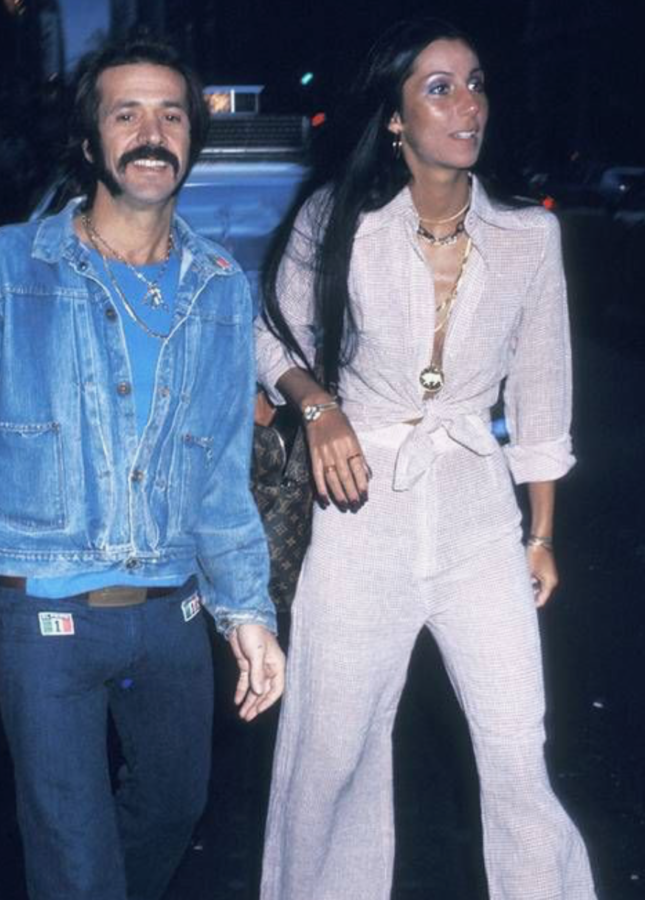Fashion trends of the 1970s
November 22, 2020
Although the 1970s were 50 years ago, the time-old saying “history repeats itself” proves there isn’t a large contrast between values, actions, fashions and ways of life from then to now.
Marginalized groups petitioned and fought for equality and inclusion, pushes for improved environmental policies were prevalent and proved successful and Americans were fighting to banish traditional familial roles, taking the nickname the “Me Decade.”
Fashions throughout the 1970s spoke a language that hadn’t been known before — with graphic T-shirts, bell bottom jeans and maxi dresses being popularized during this decade — and have continued along the bell-shaped curve known as the fashion cycle ever since.
While bell bottoms have fluctuated throughout stages such as decline and rise in popularity, as individuals now experiment with fashion, graphic tees and maxi dresses as well as patterns such as tie-dye continue to remain prevalent in today’s fashion world.
Post-Watergate, individuals sought more interest in pop culture, especially with the rising music scene. After the previous decade closed with Woodstock, hippie fashions also continued to remain folded in the dresser and worn from time to time. Frayed jeans, fringed jackets and tie-dye patterns were still worn throughout the ‘70s, as individuals tossed former fashion rules out the window and chose to express themselves freely.
The ideal of dressing without care of others’ opinions has remained tried and true in 2020 and within the past couple of years. Tossing opinions and ideals out the window is a trend that hopefully will remain popular, bringing with it new trends and a form of self-expression never seen before.
Originating in the 17th century, bell bottom pants were worn by boat workers and were slowly introduced to sailors in the U.S. Navy. The large legs allowed boat workers to roll up excess fabric when necessary to complete jobs onboard, such as washing the decks.
Within the ‘70s, bell bottom jeans were introduced into mainstream fashion, gaining popularity within pop culture. These popular denim pants are seen as a symbol of the Me Decade and have worked their way back into popular fashion today, with brands such as Free People, Altar’d State and Buckle selling more of the recycled trend.
The flare and width of the “bell” shape at the bottom of the jean can vary in size depending on the brand and how they interpret the fashion. Those who identify as male and female sported the classic denim design, blurring gender roles within dress.
The classic graphic tee has been used to portray pop culture interests, political opinions and to simply get a message across. Tees originated as undershirts, worn underneath trousers and jumpsuits.
It wasn’t until the ‘70s when graphic tees became a medium for anti-war protests and people realized something as simple as a tee could pack a powerful punch. Shirts donned peace sign logos and phrases such as “WAR IS OVER.”
Since then, the graphic tee industry has skyrocketed. Name one logo, character, TV show, movie or brand that doesn’t have their own graphic tee. You can’t do it. It’s impossible. With brands realizing they can market off of the popularity and ease of graphic tees, the incentive to create them became a whole lot easier.
Throughout movements striving for environmental and equality rights, graphic tees became their own form of protest, saying what needed to be said in a simple yet effective way.
Graphic tees take on a multitude of designs and messages, making them a universal classic for any age, demographic and gender.
In the present day, controversy arises within dress constantly. More recently, Candace Owens, political activist and author, criticized the December issue of Vogue with Harry Styles on the cover, who was wearing a dress.
“Bring back manly men,” Owens said in a tweet, shaming the musician for style choices made on the cover and throughout the magazine. Celebrities came to defend Styles for choosing to embrace himself through dress however he pleases and bashed Owens for taking a narrow-minded view.
One large ideal that has remained prevalent throughout the past 50 years is the willingness to blur and break down gender barriers within dress, allowing individuals to experiment with styles, patterns, fabrics and ways of dressing to express themselves how they please, without fear of judgement from others.







